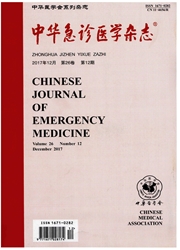

 中文摘要:
中文摘要:
目的 探讨自动体外除颤仪(AED)在抢救心搏骤停中的作用和应用方法,对比国产及进口AED的除颤和复苏效果.方法 14头北京长白猪,体质量(30±1)kg,于本院动物实验室,麻醉后左股静脉置入双腔临时起搏电极,连接医用程控刺激仪制作室颤模型.左股动脉置入动脉导管,连接PiCCO监护仪测量动脉血压及心输出量(CO)和肺血管外水指数(EVWI).心电监护证实室颤成功后,随机(随机数字法)将动物分为2组,每组7只,随机使用国产(M组)或进口(Z组)自动体外除颤仪(AED)除颤.胸骨两侧粘贴电极,按AED语音提示操作并除颤.以上过程反复进行4次,记录除颤次数及成功率.每次自主循环恢复(ROSC)后20 min进行心肌酶谱检测,同时监测CO及EVWI.实验数据计量资料采用重复测量方差分析,计数资料采用x2检验,以P<0.05为差异有统计学意义.结果 14只动物共进行54次致颤,除Z组1只第二次致颤后未能成功复苏,其余均ROSC,复苏成功率为98.1%.M组放电37次,首次除颤成功率75.0%;Z组放电32次,首次除颤成功率80.8%.从AED开机到心电信号识别完毕平均需要(29±1)s.M组及Z组各2次在首次致颤后,AED未能成功识别室颤;Z组2次将ROSC后室性心动过速,误判为室颤,但按其提示除颤后未造成不良影响.实验过程中,所有动物心率、血压及CO未见明显波动,但EVWI和肌红蛋白(MYO)随时间变化进行性升高,其中第三、第四次除颤后与基础状态相比,有显著性差异.各项检测指标M组与Z组之间未发现显著性差异.结论 AED能够安全、有效地终止室颤;国产与进口AED在信号判别能力、除颤效果与对心肌损伤方面无显著差异;对于专业医护人员,推荐使用人工除颤器,以避免AED过度依赖自动化而产生的误判.
 英文摘要:
英文摘要:
Objective To investigate the efficiency and safety of the automated external defibrillator (AED); and to compare the defibrillating efficacy between the domestic AED and the imported AED. Method Fourteen Peking white swine weighed (30 ± 1 ) kg, were anaesthetized and arterial cannula was inserted into the left femoral artery for collecting blood samples and measuring artery blood pressure, cardiac output (CO) and external vascular lung water index (EVWI) by using PiCCO monitor, and another cannula was inserted into the left femoral vein to place an electrode as a temporary pace maker, and then ventricular fibrillation (VF) was induced by using a programmed electrical stimulation instrument. The swine were divided into two groups randomly ( random number) after VF was confirmed by electrocardio-monitor,and the domestic made AED (M group, n = 7) or imported AED (Z group, n = 7) were used respectively in 7 swine of each group. The electrodes of defibrillator were stuck to the precordium and sternum separately, and defibrillation was delivered by the AED signal. The entire procedure of defibrillation was repeated four times. The number of defibrillation delivery required to get normal cardiac rhythm was recorded. Twenty minutes after restoration of spontaneous circulation (ROSC), blood sample was taken to measure myocardial enzyme. The CO and EVWI were measured too. Measurement data was analyzed by repeated ANOVA and enumeration data was analyzed by Chi-square test. A value of P 〈0.05 was regarded as being significant statistical difference. Results There were 54 episodes of VF induced in 14 swine and only one swine in Z group was dead after 2nd episode of VF, resulting in 98.1% success rate of resuscitation. There were 37 defibrillation deliveries given to swine of M group, and 75.0% produced normal cardiac rhythm after the first delivery of defibrillation,whereas 80.0% in Z group after 32 defibrillation deliveries. The length of time from AED turned on to the recognition of EC
 同期刊论文项目
同期刊论文项目
 同项目期刊论文
同项目期刊论文
 Effect of continuous compressions and 30:2 cardiopulmonary resuscitation on global ventilation/perfu
Effect of continuous compressions and 30:2 cardiopulmonary resuscitation on global ventilation/perfu Mild Hypothermia Attenuates Mitochondrial Oxidative Stress by Protecting Respiratory Enzymes and Upr
Mild Hypothermia Attenuates Mitochondrial Oxidative Stress by Protecting Respiratory Enzymes and Upr Cerebrospinal fluid biochemistry reflects effects of therapeutic hypothermia after cardiac arrest in
Cerebrospinal fluid biochemistry reflects effects of therapeutic hypothermia after cardiac arrest in Effect of rescue breathing during cardiopulmonary resuscitation on lung function after restoration o
Effect of rescue breathing during cardiopulmonary resuscitation on lung function after restoration o Load-distributing band improves ventilation and hemodynamics during resuscitation in a porcine model
Load-distributing band improves ventilation and hemodynamics during resuscitation in a porcine model 期刊信息
期刊信息
